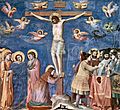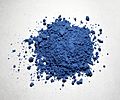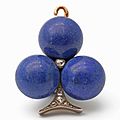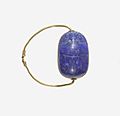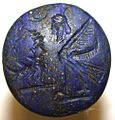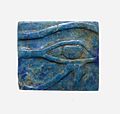Lapis lazuli facts for kids
Quick facts for kids Lapis lazuli |
|
|---|---|
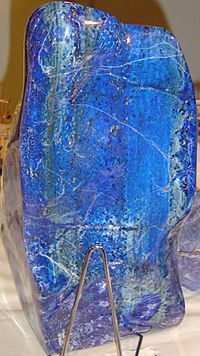
A polished specimen of lapis lazuli.
|
|
| General | |
| Category | Rock |
| Formula (repeating unit) |
mixture of minerals |
| Identification | |
| Color | Blue, mottled with white calcite and brassy pyrite |
| Mohs scale hardness | 5–5.5 |
| Luster | dull |
| Streak | light blue |
| Specific gravity | 2.7–2.9 |
| Refractive index | 1.5 |
| Other characteristics | The variations in composition cause a wide variation in the above values. |
Lapis lazuli is a beautiful blue gemstone and a type of rock. It is formed deep inside the Earth from other rocks that change under heat and pressure. This process is called metamorphism.
Lapis lazuli is famous for its amazing blue color. Its name actually means "stone of blue." People have used lapis lazuli for many things throughout history. It has been made into beads and used in jewellery since ancient times. People also carved it into small sculptures called statuettes. One of its most important uses was as a pigment (a color powder) for artists' paint. During the Middle Ages and Renaissance, lapis was ground into a fine powder and mixed with oil. Artists used this blue paint for skies and blue clothes in their artworks. You can see it in the famous fresco paintings by Giotto and the tempera paintings by Fra Angelico.
Contents
What is Lapis Lazuli Made Of?
Lapis lazuli is a metamorphic rock that is made up of several different minerals. The main mineral that gives lapis its deep blue color is called Lazurite. Other minerals like calcite (which looks white) and pyrite (which looks like shiny brass) are often found mixed in, giving lapis its unique look.
Where is Lapis Lazuli Found?
Lazurite, the main mineral in lapis lazuli, has been mined for over 6,000 years in Afghanistan. This country was the main source of lapis for ancient civilizations like the ancient Egyptians, Mesopotamians, Greeks, and Romans. Around 2000 BC, during the time of the Indus Valley civilization, a settlement called Shortugai was even built close to the lapis mines in Afghanistan.
Today, lapis lazuli is also mined in other places around the world. You can find it near Lake Baikal in Russia, in the Andes mountains near Ovalle in Chile, and in Myanmar (Burma). Other locations include Canada, Pakistan, India, and the United States (in California and Colorado).
Are There Fake Lapis Lazuli?
Sometimes, lapis lazuli is "simulated" or copied using chemicals. This means it's not real lapis lazuli, but something made to look like it. These copies often use artificial ultramarine (a blue pigment) and other chemicals. There are also other materials that can be used as substitutes for real lapis.
Images for kids
-
This statuette carved in Lapis lazuli was possibly made in India.
-
Ancient Egyptian cult image of Ptah; 945–600 BC; lapis lazuli; height of the figure: 5.2 cm; Metropolitan Museum of Art (New York City)
-
Natural ultramarine pigment made from ground lapis lazuli. During the Middle Ages and Renaissance it was the most expensive pigment available (gold being second) and was often reserved for depicting the robes of Angels or the Virgin Mary
-
Sumerian necklace beads; 2600–2500 BC; gold and lapis lazuli; length: 54 cm; Metropolitan Museum of Art (New York City)
-
Sumerian necklace; 2600–2500 BC; gold and lapis lazuli; length: 22.5 cm; from the Royal Cemetery at Ur (Iraq); Metropolitan Museum of Art
-
Ancient Egyptian scarab finger ring; 1850–1750 BC; lapis lazuli scarab set in gold plate and on a gold wire ring lapis-lazuli; diameter: 2.5 cm; Metropolitan Museum of Art
-
Ancient Egyptian plaque with an Eye of Horus; 664–332 BC; lapis lazuli; length: 1.8 cm; Metropolitan Museum of Art
-
Large lapis lazuli specimen from Afghanistan's Hindu Kush mountains. National Museum of Natural History (Washington, D.C.)
See also
 In Spanish: Lapislázuli para niños
In Spanish: Lapislázuli para niños





